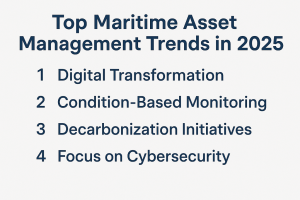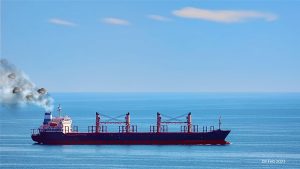Discover the top maritime asset management trends in 2025 transforming how ships are maintained, operated, and optimized. Learn about smart fleet solutions, lifecycle cost efficiency, and future-ready technologies driving the maritime industry forward.
Why Asset Management Matters in Modern Maritime Operations?
Shipowners today face a different world than a decade ago. Compliance is stricter, margins are tighter, and expectations around sustainability and digital performance are rising. Whether you manage a small coastal fleet or a global shipping enterprise, ship asset lifecycle management is no longer just a maintenance checklist—it’s a strategic discipline.
According to DNV’s Maritime Forecast to 2050, the operational lifetime of ships will increasingly depend not just on steel and machinery, but on how well data, predictive analytics, and emission metrics are managed. At the same time, UNCTAD’s Review of Maritime Transport (2024) reports that over 80% of the world’s trade is carried by sea, making efficient and sustainable asset performance more critical than ever.
Asset management, in this context, means maximizing a vessel’s lifecycle performance—from design and delivery to operation, maintenance, and decommissioning—while controlling risk, cost, and environmental impact.
The Evolving Definition of Maritime Asset Management
In 2025, maritime asset management covers far more than technical upkeep. It includes:
-
Fleet performance optimization using real-time data
-
Digital twin technology to simulate wear and predict failures
-
Regulatory readiness (CII, EU ETS, IHM, etc.)
-
Lifecycle cost modeling for better CapEx and OpEx decisions
-
Sustainability alignment with ESG frameworks and IMO targets
Leading classification societies like Lloyd’s Register, ClassNK, and Bureau Veritas now certify asset management systems under ISO 55000 standards, signaling that this field is as much about strategic foresight as engineering excellence.
Key Asset Management Trends Transforming the Maritime Industry in 2025
Digital Twins for Predictive Maintenance
A digital twin is a virtual replica of a vessel’s systems that receives real-time input from onboard sensors. By comparing expected and actual performance, managers can predict failures and intervene before costly breakdowns occur. Companies like Wärtsilä, DNV, and Kongsberg now offer digital twin solutions integrated with condition-based monitoring (CBM) platforms.
Case Example: A container operator using Wärtsilä’s Expert Insight platform reduced unplanned downtime by 30% across its fleet within 12 months. This was achieved by detecting early wear on turbochargers and shaft bearings through machine learning.
Fleet-Wide Performance Dashboards
Asset managers now use central dashboards to monitor:
- Fuel efficiency (linked to CII scores)
- CO₂ emissions (for EU ETS and IMO DCS compliance)
- Hull fouling levels (affecting drag and fuel use)
- Route optimization vs engine wear trade-offs
ABS MyDigitalFleet™ and DNV Veracity platforms allow operators to consolidate technical, commercial, and environmental data in one place—empowering smarter decisions across the ship asset lifecycle.
Asset Health Index (AHI) and Condition-Based Class
Traditional class surveys rely on fixed intervals. In 2025, many vessels move toward Condition-Based Class (CBC), where surveys are scheduled based on actual asset condition, not calendar dates. The Asset Health Index ranks components (e.g., engines, pumps, ballast tanks) by failure risk. This reduces unnecessary dry-docking and aligns with IMO goals for reducing unnecessary emissions and waste.
Real-World Data: DNV’s CBC framework has been adopted by over 500 vessels as of early 2025, with average savings of $70,000–$120,000 per dry-docking cycle.
Lifecycle Cost Optimization (LCC)
A ship’s lifecycle cost includes acquisition, operation, maintenance, and disposal. Tools like Total Cost of Ownership (TCO) calculators and Ship Lifecycle Modelling (SLM) are now widely used by asset managers.
Why it matters: Fleet renewal decisions are no longer based on age alone. A 15-year-old ship with strong maintenance and upgraded systems may outperform a 7-year-old ship with poor asset discipline.
Sustainable Asset Strategies and ESG Reporting
With ESG disclosure becoming mandatory in the EU and other jurisdictions, asset managers must now track:
- Energy Efficiency Existing Ship Index (EEXI)
- Carbon Intensity Indicator (CII)
- Inventory of Hazardous Materials (IHM)
- Scrapping compliance under the Hong Kong Convention
Green scrapping programs, low-carbon retrofit investments, and alternative fuel readiness are becoming integral to asset lifecycle planning.
Integrated Shore-to-Ship Asset Management
Remote monitoring centers (RMCs) are emerging as command hubs for technical decisions. These centers—like Synergy Marine’s Digital Command Center—monitor:
- Engine load fluctuations
- Vibration anomalies
- Lube oil condition
- Emergency signals
In 2024, 80% of new large vessel orders included provisions for real-time data streaming to shore centers, according to Clarksons Research.
–
Challenges in Maritime Asset Management
Fragmented Data Systems
Many shipowners still rely on siloed systems—Excel sheets, paper logs, and standalone PMS software. Integrating shipboard data with cloud analytics remains a technical and cultural challenge.
Solution: Standardized APIs and platforms like OneOcean and Thetius DataHub now offer plug-and-play solutions compatible with class and flag state reporting tools.
Cybersecurity Risks
The move to digital twins and remote monitoring increases exposure to cyberattacks. IMO’s Resolution MSC.428(98) mandates cybersecurity risk management as part of the Safety Management System (SMS), and asset managers must now include IT and OT security audits in their routines.
Skill Gap
Managing ship asset lifecycles today demands new skills—data science, digital modeling, ESG strategy—not traditionally taught in maritime schools. Progressive firms now train their superintendents in data literacy, ISO 55001, and digital fleet command systems via institutions like IMAREST and Lloyd’s Maritime Academy.
Real-World Applications of 2025 Asset Management Trends
Case 1: Offshore Wind Service Fleet
A European company operating CTVs and SOVs adopted AI-powered engine diagnostics to reduce maintenance delays during offshore transfers. The result? A 22% reduction in O&M downtime and increased charter reliability with wind farm clients.
Case 2: Tanker Company Facing CII Non-Compliance
An MR tanker fleet facing poor CII scores used route-voyage simulation tools and hull biofouling analytics to improve ratings from “E” to “C” within one year. The fleet avoided commercial penalties from charterers demanding A–C rated ships by 2025.
–
Frequently Asked Questions (FAQ)
What is maritime asset management?
It refers to the strategic planning, operation, maintenance, and disposal of ships to optimize performance, cost, compliance, and sustainability across the vessel lifecycle.
How does asset management differ from technical ship management?
Technical management is part of asset management, focusing on day-to-day ship operations. Asset management includes financial planning, ESG compliance, lifecycle modeling, and digital innovation.
What technologies support maritime asset management in 2025?
Digital twins, fleet dashboards, condition-based class systems, AI-powered diagnostics, and ESG tracking tools are now standard.
What is the role of classification societies in asset management?
They certify systems, approve condition-based classes, and guide compliance with ISO 55000 and IMO regulations. Societies like DNV and ABS offer digital solutions tailored for asset managers.
Can asset management improve a vessel’s CII or EEXI rating?
Yes. Better maintenance, optimized routes, hull cleaning schedules, and equipment upgrades directly impact carbon efficiency scores.
Is asset management relevant for small fleets?
Absolutely. Even owners of 2–3 ships can benefit from improved fuel use, longer dry-docking intervals, and stronger resale value with good asset discipline.
Conclusion: Building Smarter, Greener, Longer-Lasting Ships
In 2025, maritime asset management is not an optional function—it’s the strategic compass that keeps shipping companies afloat in a storm of regulations, market shifts, and digital disruption.
By embracing trends like digital twins, condition-based class, ESG tracking, and smart fleet dashboards, shipowners are gaining better control over their vessels—not just technically, but commercially and environmentally.
Whether you’re a superintendent, shipowner, maritime student, or ESG analyst, understanding the lifecycle of ship assets will be key to navigating the maritime economy of the future.
The vessel of tomorrow doesn’t just float—it performs, adapts, and endures.
References
-
DNV. (2024). Maritime Forecast to 2050. https://www.dnv.com
-
UNCTAD. (2024). Review of Maritime Transport. https://unctad.org
-
Wärtsilä. (2024). Expert Insight Performance Reports. https://www.wartsila.com
-
Lloyd’s Register. (2024). Asset Management Standards and Class Services. https://www.lr.org
-
Clarksons Research. (2024). Digital Shipbuilding Trends. https://www.clarksons.net
-
ABS. (2024). MyDigitalFleet Platform Overview. https://www.eagle.org
-
Paris MoU. Annual Inspection Data. https://www.parismou.org
-
IMO. (2020). Guidelines on Cyber Risk Management MSC.428(98). https://www.imo.org
-
IMAREST. Training for Marine Asset Professionals. https://www.imarest.org



